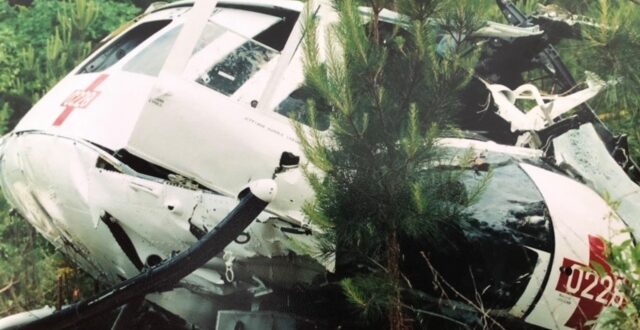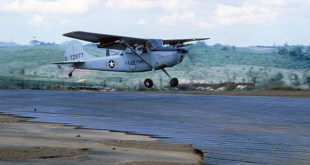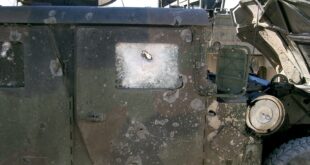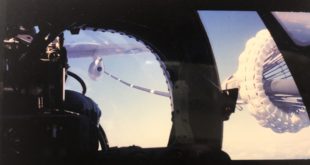by Fred Ganous, SGM, USA (Ret)
The pilot in command reached up and grasped the rescuer’s shirt. “Hey asshole,” he growled. “That’s not what you say to the ones you are trying to help!”
The medevac mission had ended, and the burn patient was dropped off successfully at the hospital. The aircrew had worked a long day. They were a “Flat Iron,” as they were called, a military-operated medevac that sometimes received calls named “mast missions” or “Military Assistance for Safety and Traffic.” The helicopter was en route to its Fort Rucker, Alabama, home station.
Ascending to an altitude of 2,500 feet, the pilot in charge, Chief Warrant 4 Mark Crawford, was on the controls when a loud eruption was heard. This sound seemed as if a rocket-propelled grenade had hit the aircraft. The crew wondered if the UH-1V Huey helicopter they were flying was just struck by a civilian fixed-wing airplane they had recently heard in the vicinity.
READ MORE from Fred Ganous about his Death Angels unit in Iraq.
Suddenly the chopper descended its nose about 40 degrees, as it began to roll right while the nose yawed to the left.
The pilot in charge said those magical words that those in Army aviation had often heard: “Sir, you have the controls.”
Army civilian Joe Jack Hudgens responded: “What the hell am I gonna do with it”?
The meaning was that the pilot in charge passed the flight controls to the pilot in command, usually a more experienced aviator.
As the Flat Iron helicopter lost altitude, both pilots worked feverishly to maintain their composure and battle the aircraft for domination. During this time, the helicopter was inverted and into a spin while Joe Jack continued to fight to turn it upright.
Increasing and decreasing the throttle, all while working what pedal controls were left, Joe slowed the flat spin of the helo.
Unexpectedly the medic behind them spoke up.
“I saw components of what looked like details of the vertical fin passing us out the window!”
Joe knew there was an issue with the tail section but could not speculate that the helicopter’s vertical pylon was peeling apart. Losing altitude, Joe restrained the aircraft the best he could until he saw the ground come fast approaching.
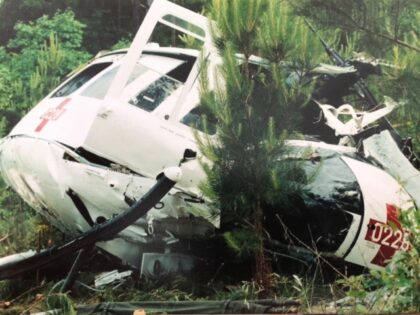
The Huey helicopter crashed violently into a dense patch of pine trees, removing many of them. At the same time, the main rotor blades functioned as a chainsaw, taking out the tops.
Finally, upon impact, the Huey helicopter rumbled to a complete stop. With two aviators, an army medic, and a firefighter in the back, the effort to maintain survival quickly ended.
The helicopter had finally come to rest with its vertical pylon broken off, and the cockpit, where the aviators struggled to stay alive, was decimated.
Joe opened his eyes to see the remains of what was left of the aircraft he helped struggle to control so that those onboard would survive.
After a couple blinks of his eyes, the helicopter pilot discovered he was seeing two different pictures. One eye was capturing the destruction of the dash where the instrumentation had been left in ruins. The other was staring at the top of his boot.
One of the pilot’s eyes had been disengaged from the eye socket. He was seeing out of both eyes – each from its own position.
The medevac team’s fireman removed the injured from within the demolished aircraft, leaving Joe’s lifeless body behind, thinking that the pilot had died on impact. Everyone else was taken to a rendezvous point about 50 feet away to a clearing, where the injured would wait until emergency personnel arrived.
As the crew tried to evaluate one another for injuries after the crash, they heard a noise. The pilot Joe Hudgens was making enough racket to alert them he was still alive.
One of the crewmembers returned to the crash to retrieve the stricken pilot. A civilian rescue team soon arrived at the casualty point to assist the injured crew.
“Hey, we got a bad one here with his eye blown out!” one yelled.
The pilot in command, Joe Jack Hudgens, reached up and grasped the rescuer’s shirt.
“Hey asshole,” he growled. “That’s not what you say to the ones you are trying to help!”
The pilot in charge, Chief Warrant 4 Mark Crawford, had a broken back. He was clueless about the initial injury, but knew something terrible was wrong. Mark was very athletic and in excellent physical form, but his body had encountered its match with the crash of his aircraft.
Three of the four crew were severely injured, while one was oblivious to his wounds – and that crewmember did most of the work carrying the rest to a secure area.
While the pilots had been fighting the stricken Huey helicopter to the ground, the crew had made critical radio calls for help. One of the crewmembers even crawled back to the crash to try and get a fixed location with a GPS in hopes that someone would hear the area of the downed aircraft.
As the injured helicopter crew was being assessed for emergency transport, another helicopter touched down in a very tight landing zone for pickup.
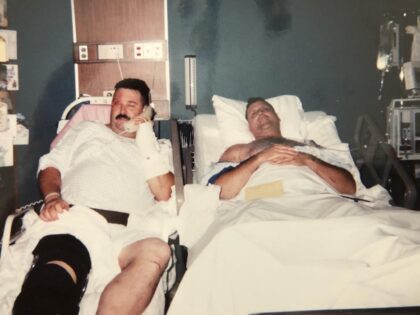
Joe Jack on the left, with his eyeball returned to its socket; Mark is on the right.
Once the military completed a comprehensive investigation, it was determined that the helicopter had lost the use of its tail rotor due to spar fatigue in the vertical fin.
Chief Warrant Officer 4 Mark Crawford’s career would end.
Chief Warrant Officer 4 Joe Jack Hudgens recouped his eyeball. He later passed an Army flight physical, and returned to Iraq with us in 2006. He had an 18-month deployment supporting OIF 06-08 as a UH-60 Blackhawk pilot.
Both aviators would be awarded the “Broken Wing” award for their valiant effort to recover the helicopter under such disastrous circumstances. I have personally served alongside both of these pilots, and their knowledge of the aircraft and dedication to the service of this country is exemplary.
Fred Ganous is a combat veteran of the Iraq war, and has spent his career in aviation. His Death Angels logo, below, is known throughout the community.
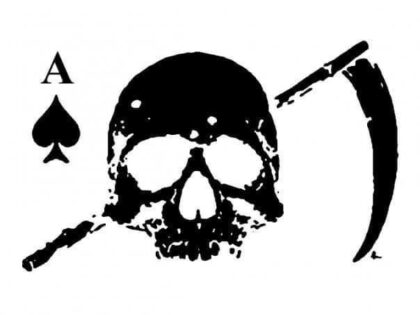
 Soldier of Fortune Magazine The Journal of Professional Adventurers
Soldier of Fortune Magazine The Journal of Professional Adventurers


